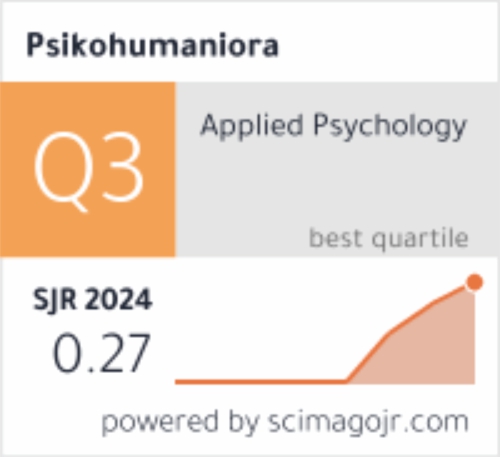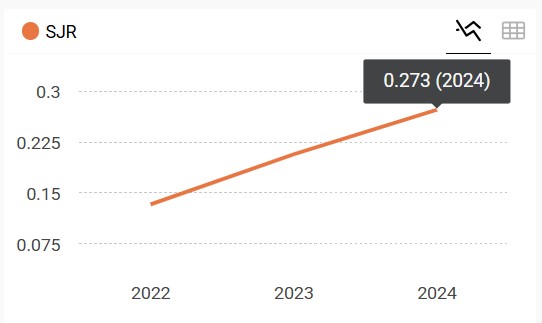Effect of safety climate on safety behavior in employees: The mediation of safety motivation
DOI:
https://doi.org/10.21580/pjpp.v4i2.3346Keywords:
safety behavior, safety climate, safety motivationAbstract
The number of work accidents in production employees is high. One reason is the lack of compliance of employees with workplace safety rules. The necessary aspects that can improve workplace safety are safety climate and safety motivation. The purpose of this study was to examine the effect of safety climate on safety behavior both directly and indirectly mediated by safety motivation. Three scales were used in this study, namely the safety behavior scale, the safety climate scale, and the safety motivation scale. The Cronbach’s Alpha coefficients were 0.898, 0.922, and 0.896. The respondents were 78 employees in the production, processing, and quality assurance section. Data were analyzed using regression analysis. The result showed the direct effect (β = 0.272) and the indirect effect of safety climate on safety behavior (β = 0.281). The effect of climate safety on safety behavior was partially mediated by safety motivation.
Downloads
References
Azwar, S. (2013). Penyusunan skala psikologi. Yogyakarta: Pustaka Pelajar.
Baron, R. M., & Kenny, D. A. (1986). The moderator-mediator variable distinction in social psychological research: Conceptual, strategic, and statistical considerations. Journal of Personality and Social Psychology, 51(6), 1173–1182. https://doi.org/10.1037/0022-3514.51.6.1173
Bird, F. E., & Germain, G. L. (1996). Practical loss control leadership (Revised Edition). USA: DNV GL Business Assurance.
BPJS News Team. (2019, January 16). Angka kecelakaan kerja cenderung meningkat, BPJS Ketenagakerjaan bayar santunan Rp1,2 triliun. Retrieved from https://www.bpjsketenagakerjaan.go.id/berita/23322/Angka-Kecelakaan-Kerja-Cenderung-Meningkat,-BPJS-Ketenagakerjaan-Bayar-Santunan-Rp1,2-Triliun
Budiono, S. (2003). Bunga rampai Hiperkes dan kesehatan kerja. Semarang: Badan Penerbit Universitas Diponegoro.
Dessler, G. (2005). Human resource management. New Jersey: Prentice-Hall.
Griffin, M., Neal, A., & Neale, M. (2000). The contribution of task performance and contextual performance to effectiveness: Investigating the role of situational constraints. Applied Psychology, 49(3), 517–533. https://doi.org/10.1111/1464-0597.00029
Heinrich, H. W. (1980). Industrial accident prevention. (D. Petersen & N. R. Roos, Eds.) (5th ed.). New York: McGraw-Hill.
Hofmann, D. A., & Stetzer, A. (1996). A cross-level investigation of factors influencing unsafe behaviors and accidents. Personnel Psychology, 49(2), 307–339. https://doi.org/10.1111/j.1744-6570.1996.tb01802.x
Huda, U. F., Sukmawati, A., & Sumertajaya, I. M. (2016). Model perilaku keselamatan kerja karyawan pada industri berisiko tinggi. Jurnal Manajemen Teknologi, 15(1), 51–66. https://doi.org/10.12695/jmt.2016.15.1.4
Kavianian, H. R., & Wentz, C. A. (1990). Occupational and environmental safety engineering and management. New York: Van Nostrand Reinhold.
Lingard, H. (2002). The effect of first aid training on Australian construction workers’ occupational health and safety motivation and risk control behavior. Journal of Safety Research, 33(2), 209–230. https://doi.org/10.1016/S0022-4375(02)00013-0
Neal, A., & Griffin, M. A. (2002). Safety climate and safety behaviour. Australian Journal of Management, 27(1), 67–75. https://doi.org/10.1177/031289620202701S08
Neal, A., & Griffin, M. A. (2006). A study of the lagged relationships among safety climate, safety motivation, safety behavior, and accidents at the individual and group levels. Journal of Applied Psychology, 91(4), 946–953. https://doi.org/10.1037/0021-9010.91.4.946
Ningsih, A. R., & Wahyudiono, Y. D. A. (2013). Evaluasi pelaksanaan behavior based safety pada program stop dalam membentuk perilaku aman tenaga kerja di pt x tahun 2013. The Indonesian Journal of Occupational Safety and Health, 2(1), 35–44.
Probst, T. M., & Brubaker, T. L. (2001). The effects of job insecurity on employee safety outcomes: Cross-sectional and longitudinal explorations. Journal of Occupational Health Psychology, 6(2), 139–159. https://doi.org/10.1037/1076-8998.6.2.139
Safety Sign Indonesia. (2015, May 25). Setiap 15 detik, 1 pekerja di dunia meninggal akibat kecelakaan kerja. Safety Sign Indonesia. Retrieved from https://www.safetysign.co.id/news/154/Setiap-15-Detik-1-Pekerja-di-Dunia-Meninggal-Akibat-Kecelakaan-Kerja
Setiawan, M. A., & Agustina, T. S. (2014). Pengaruh safety climate terhadap kecelakaan kerja dengan safety behavior sebagai variabel intervening pada karyawan PT Panca Wana Indonesia di Krian. Jurnal Manajemen Teori dan Terapan, 7(2), 125–136. https://doi.org/10.20473/JMTT.V7I2.2706
Snyder, L. A., Krauss, A. D., Chen, P. Y., Finlinson, S., & Huang, Y.-H. (2008). Occupational safety: Application of the job demand-control-support model. Accident Analysis & Prevention, 40(5), 1713–1723. https://doi.org/10.1016/j.aap.2008.06.008
Sujadiyanto, R. G. (2017). Komitmen afektif sebagai mediator dalam hubungan antara persepsi dukungan organisasi (POS) dan safety behavior pada karyawan departemen operasional PT Pusri Palembang. Undergraduate thesis. Universitas Sanata Dharma, Yogyakarta.
Sulistiobudi, R. A., & Kadiyono, A. L. (2017). Menumbuhkan keterlibatan positif dalam bekerja: Melalui iklim kompetisi ataukah pengembangan kompetensi? Psikohumaniora: Jurnal Penelitian Psikologi, 2(1), 60–80. https://doi.org/10.21580/pjpp.v2i1.1273
Taqwa, K. Z. (2017). Hubungan antara safety climate dengan safety behavior pada karyawan departemen produksi PT Pura Barutama Unit Offset Kudus. Undergraduate thesis. Universitas Negeri Semarang, Semarang.
Vinodkumar, M. N., & Bhasi, M. (2010). Safety management practices and safety behaviour: Assessing the mediating role of safety knowledge and motivation. Accident Analysis & Prevention, 42(6), 2082–2093. https://doi.org/10.1016/j.aap.2010.06.021
Vitri, R. S. (2003). Hubungan antara dukungan supervisor (supervisor support) dan dukungan rekan kerja (coworker support) dengan motivasi keselamatan (safety motivation). Undergraduate thesis. Universitas Surabaya, Surabaya.
Winarsunu, T. (2008). Psikologi keselamatan kerja. Malang: UPT Penerbitan Universitas Muhammadiyah Malang.
Zohar, D. (2003). Safety climate: Conceptual and measurement issues. In J. C. Quick & L. E. Tetrick (Eds.), Handbook of occupational health psychology. (pp. 123–142). Washington: American Psychological Association. https://doi.org/10.1037/10474-006
Downloads
Published
How to Cite
Issue
Section
License
The copyright of the accepted article shall be assigned to the publisher of the journal. The intended copyright includes the right to publish the article in various forms (including reprints). The journal maintains the publishing rights to published articles.
In line with the license, authors and any users (readers and other researchers) are allowed to share and adapt the material only for non-commercial purposes. In addition, the material must be given appropriate credit, provided with a link to the license, and indicated if changes were made. If authors remix, transform, or build upon the material, authors must distribute their contributions under the same license as the original.



